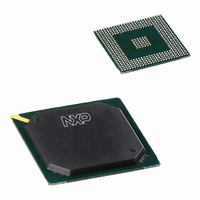PNX1500E/G,557 NXP Semiconductors, PNX1500E/G,557 Datasheet - Page 169

PNX1500E/G,557
Manufacturer Part Number
PNX1500E/G,557
Description
IC MEDIA PROC 240MHZ 456-BGA
Manufacturer
NXP Semiconductors
Specifications of PNX1500E/G,557
Applications
Multimedia
Core Processor
TriMedia
Controller Series
Nexperia
Interface
I²C, 2-Wire Serial
Number Of I /o
61
Voltage - Supply
1.14 V ~ 1.26 V
Operating Temperature
0°C ~ 85°C
Mounting Type
Surface Mount
Package / Case
456-BGA
Lead Free Status / RoHS Status
Lead free / RoHS Compliant
Program Memory Type
-
Ram Size
-
Lead Free Status / Rohs Status
Compliant
Other names
568-1296
935277746557
PNX1500E/G
935277746557
PNX1500E/G
- Current page: 169 of 828
- Download datasheet (8Mb)
Philips Semiconductors
Volume 1 of 1
PNX15XX_SER_3
Product data sheet
Figure 6:
(external clock)
Clock Detection Circuit
2.9 Clock Detection
en
counter
Toggle
Flop
The GPIO interrupt comes from the GPIO block and is the “OR” of all the FIFO and
timestamp registers. This way a GPIO pin can be monitored and when an event
occurs the interrupt to the processor awakes the system. Bit ‘0’ of the
CLK_WAKEUP_CTL enables the GPIO interrupt.
The external signal is the dedicated GPIO pin 15. This signal must be active for at
least one xtal_clk clock period. It is expected that this signal will stay active until the
CPU responds which will be several xtal clock periods. Bit ‘1’ of the
CLK_WAKEUP_CTL enables the external interrupt. GPIO[15] must be low when
entering in power down mode since the wake-up procedure is started when the
GPIO[15] pin is set to high for at least one xtal_clk clock cycle.
Clock detection is required in the case of an external clock being removed or
disconnected e.g if the video cable to the set top box is suddenly removed and an
external video clock thereby stopped. this type of event is detected by the Clock
module. Also the Clock module can detect when the cable is re-connected and a
clock is present again.
These events are flagged by an interrupt which is routed to the TM3260.
The clock detection will be done on the following clocks inputs to PNX15xx Series:
Clock detection is done based on a 5-bit counter running at the crystal clock
frequency. The implementation detects clocks between 1 MHz and 200 MHz. It will
take up to 2 s from when the clock is removed until the interrupt condition is
generated. A block diagram of the clock detection circuit is shown in
xtal_clk
•
•
•
•
•
VDI_CLK1 (clk_vip)
AI_SCK
AO_SCK
VDI_CLK2 (clk_fgpi)
VDO_CLK2 (clk_fgpo)
32
xtal_clk
en
Rev. 3 — 17 March 2006
xtal_clk
comp
clock_present
detect
edge
Chapter 5: The Clock Module
© Koninklijke Philips Electronics N.V. 2006. All rights reserved.
pls2lvl
PNX15xx Series
PIO
INT
Figure
intrpt_clk
6.
5-18
Related parts for PNX1500E/G,557
Image
Part Number
Description
Manufacturer
Datasheet
Request
R

Part Number:
Description:
Manufacturer:
NXP Semiconductors
Datasheet:
Part Number:
Description:
Digital Signal Processors & Controllers - DSP, DSC NEXPERIA MEDIA PROC 240MHZ
Manufacturer:
NXP Semiconductors
Part Number:
Description:
Digital Signal Processors & Controllers - DSP, DSC PNX1500, 240MHZ
Manufacturer:
NXP Semiconductors
Part Number:
Description:
NXP Semiconductors designed the LPC2420/2460 microcontroller around a 16-bit/32-bitARM7TDMI-S CPU core with real-time debug interfaces that include both JTAG andembedded trace
Manufacturer:
NXP Semiconductors
Datasheet:

Part Number:
Description:
NXP Semiconductors designed the LPC2458 microcontroller around a 16-bit/32-bitARM7TDMI-S CPU core with real-time debug interfaces that include both JTAG andembedded trace
Manufacturer:
NXP Semiconductors
Datasheet:
Part Number:
Description:
NXP Semiconductors designed the LPC2468 microcontroller around a 16-bit/32-bitARM7TDMI-S CPU core with real-time debug interfaces that include both JTAG andembedded trace
Manufacturer:
NXP Semiconductors
Datasheet:
Part Number:
Description:
NXP Semiconductors designed the LPC2470 microcontroller, powered by theARM7TDMI-S core, to be a highly integrated microcontroller for a wide range ofapplications that require advanced communications and high quality graphic displays
Manufacturer:
NXP Semiconductors
Datasheet:
Part Number:
Description:
NXP Semiconductors designed the LPC2478 microcontroller, powered by theARM7TDMI-S core, to be a highly integrated microcontroller for a wide range ofapplications that require advanced communications and high quality graphic displays
Manufacturer:
NXP Semiconductors
Datasheet:
Part Number:
Description:
The Philips Semiconductors XA (eXtended Architecture) family of 16-bit single-chip microcontrollers is powerful enough to easily handle the requirements of high performance embedded applications, yet inexpensive enough to compete in the market for hi
Manufacturer:
NXP Semiconductors
Datasheet:

Part Number:
Description:
The Philips Semiconductors XA (eXtended Architecture) family of 16-bit single-chip microcontrollers is powerful enough to easily handle the requirements of high performance embedded applications, yet inexpensive enough to compete in the market for hi
Manufacturer:
NXP Semiconductors
Datasheet:
Part Number:
Description:
The XA-S3 device is a member of Philips Semiconductors? XA(eXtended Architecture) family of high performance 16-bitsingle-chip microcontrollers
Manufacturer:
NXP Semiconductors
Datasheet:

Part Number:
Description:
The NXP BlueStreak LH75401/LH75411 family consists of two low-cost 16/32-bit System-on-Chip (SoC) devices
Manufacturer:
NXP Semiconductors
Datasheet:

Part Number:
Description:
The NXP LPC3130/3131 combine an 180 MHz ARM926EJ-S CPU core, high-speed USB2
Manufacturer:
NXP Semiconductors
Datasheet:

Part Number:
Description:
The NXP LPC3141 combine a 270 MHz ARM926EJ-S CPU core, High-speed USB 2
Manufacturer:
NXP Semiconductors

Part Number:
Description:
The NXP LPC3143 combine a 270 MHz ARM926EJ-S CPU core, High-speed USB 2
Manufacturer:
NXP Semiconductors










